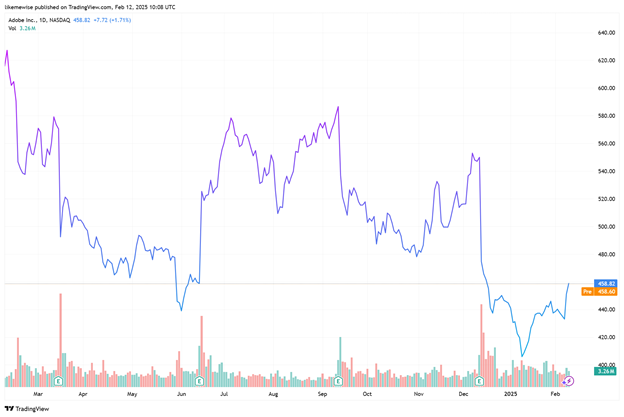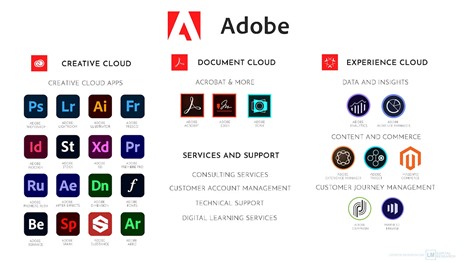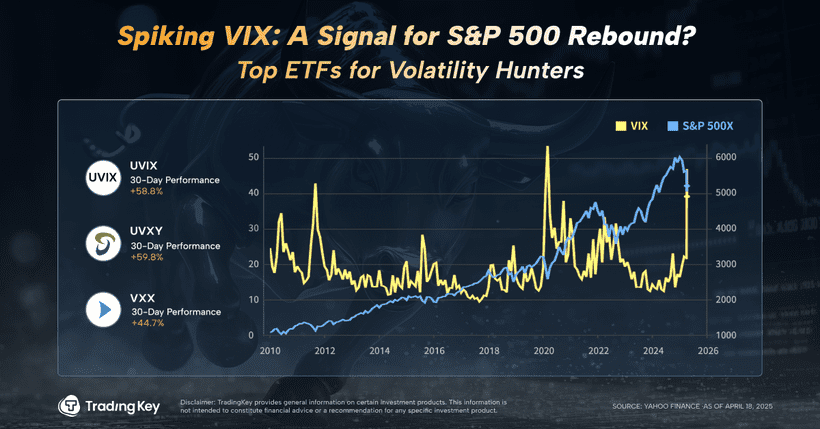Adobe's AI Odyssey: Navigating Unprecedented Development and Challenges



Source: TradingView
Key Takeaways:
- Adobe is a global SaaS industry leader operating through three main business segments, with revenue mainly from software licensing and subscription services.
- Adobe invests heavily in AI integration across its Document Cloud, Creative Cloud, and Digital Experience Cloud segments, with each showing potential particularly with non-enterprise customers..
- Considering Adobe's projected revenue growth of around 10%, the average valuation of peer companies is 10 times PS ratio. We maintain a "Hold" rating, with a reference price range of $420–$540, and expects Adobe's AI R&D and monetization could continue to attract investor enthusiasm.
Company Overview: A Global SaaS Power House
Founded in 1982, Adobe has established itself as a global leader in the digital industry. The company operates through three major business segments: Creative Cloud, Document Cloud, and Experience Cloud. These segments encompass over 40 creative software solutions, including renowned PDF software and CRM marketing software. Adobe's journey began with PostScript, a revolutionary page description language, and has since evolved into a dominant force in the SaaS industry over the past 42 years. This transformation was achieved through a combination of innovative product development, strategic acquisitions, and a successful shift to a subscription-based model. Today, Adobe's software is integral to a wide range of creative and business applications, solidifying its position as a powerhouse in the digital world.
Figure 1: 3 major business segments of Adobe

Source: Adobe
With a rich history of providing innovative design and editing software solutions,Adobe has solidified its position as a leader in the software domain. Its flagship products, including Photoshop and Illustrator, have become the de facto standard for designers worldwide, commanding a significant market share. As of the latest industry reports, Adobe's design software suite holds approximately 60% of the professional design software market, a testament to its brand dominance and user loyalty.
Adobe's revenue streams primarily stem from software licensing and subscription services, a model that has proven to be both lucrative and stable. This company reported $21.5 billion in annual revenue for fiscal year 2024, marking an increase from the previous year. The subscription-based model remains the cornerstone of its revenue stream, accounting for approximately 82% of total revenue. This highlights the success of Adobe’s shift to a recurring revenue model, which provides predictable and stable cash flow. The growth in subscription revenue also reflects strong customer retention and the continued adoption of Adobe’s Creative Cloud and Document Cloud services.
Over the past ten years, Adobe shows a yearly revenue growth of 22%, gross margins over 85%, and increasing recurring income, being priced as a growth company. Despite being down 40% from its all-time high last year, it remains in question whether investors have overreacted to its recent weak guidance, making a detailed analysis timely.
Generative AI and Transformation in Action
In the current landscape of rapid technological advancement, artificial intelligence (AI) has emerged as a pivotal force reshaping various industries, and Adobe Inc. stands at the forefront of this transformative wave, exhibiting substantial investment potential. Adobe's AI Monetization shows different development statuses in its major business segments:
1) Document Cloud AI: Expected to increase the user payment rate. AI-powered assistants in Acrobat enhance functionality. They can summarize documents and generate emails. Currently, with 500 million monthly active users and a low payment rate of under 5%, the value - added by AI may significantly boost paid subscriptions.
In FY24Q4, the Document Cloud business significantly contributed to the over-expected growth. The revenue of the Document Cloud reached $0.84 billion, with a YOY growth of 16.9%. With the wide integration of Document AI products on various platforms, the revenue of the Document Cloud is expected to maintain strong growth.
2) Creative Cloud AI: Expected to not only continue to increase the ARPU (Average Revenue Per User) in the professional design software market but also penetrate the non-professional market. AI-integrated features like generative fill in Photoshop have increased professional users' productivity. For non-professionals, Adobe Express with generative AI has attracted new users. According to Grand View Research, the global digital content creation market was valued at $32 billion in 2024 and is estimated to grow at a CAGR of 13.9% from 2025 to 2030. The digital creative industry is expected to maintain a high growth rate in the coming years this opens a vast market potential.
In FY24Q4, the revenue of the Creative Cloud was $5.3 billion, with a YOY growth of 10.3%, slightly exceeding the VA consensus estimate. The usage of Firefly in the Creative Cloud increased to 16 times YOY, with 4 times in a single quarter, showing an accelerating growth trend. In addition, in FY24Q4, the company upgraded the Creative Cloud AI in two major aspects: releasing a video model and integrating it with Premiere Pro, and launching GenStudio to emphasize enterprise customization capabilities. It is expected that the commercialization of Creative Cloud AI will accelerate in FY25.
3) Digital Experience AI: Expected to form an AI-data flywheel with the Creative Cloud business, thereby enhancing product competitiveness and securing more marketing budgets from customers. The Experience Cloud benefits from AI - driven data analysis. It enables personalized marketing, and companies using it have reported a 25% increase in conversion rates.
In FY24Q4, the revenue of the Digital Experience business was $1.39 billion, with a YOY growth of 10.3%. The revenue of the Digital Experience business exceeded expectations mainly due to the rapid growth of subscriptions for core products such as Adobe Experience Manager and Adobe Journey Optimizer. The company integrated GenStudio with EX products, which is expected to achieve application empowerment in marketing scenarios through enterprise-customized AI.
AI Product Innovation: Highly Competitive but Promising
Adobe's journey in AI product innovation presents a mixed yet promising scenario. First of all, Adobe is well-positioned to capitalize on this trend, given its early investment in AI and its deep understanding of the design industry. However, the company also faces risks, such as rapid technological obsolescence and intensifying competition. To mitigate these risks, Adobe must continue to innovate and differentiate its products, while also maintaining its focus on customer satisfaction and user experience.
To capitalize on these AI-driven opportunities, Adobe focuses on model development. It has developed its own Firefly model and integrated third-party models like Sora. Regarding copyright and data management, Adobe ensures Firefly - generated content is copyright - compliant and uses its vast data from past acquisitions for model training. In terms of product integration and pricing, AI is integrated across its product portfolio, and AI - enabled functions have been implemented to ensure profitability.
Chart 1: The Adobe AI Alternatives in 2025
Category | Competing Software | Adobe Strengths | Weaknesses |
CMS | WordPress, Drupal | Advanced AI-driven personalization, enterprise-grade features | Expensive, steep learning curve |
Photo Editing | GIMP, Affinity Photo | AI-powered tools (e.g., Neural Filters, Auto Select), industry standard | Subscription-based, expensive |
3D Modeling | Blender | AI-powered texture generation, seamless integration with Adobe suite | Expensive, less community-driven |
RAW Photo Processing | Darktable | AI-powered auto-tagging, cloud integration, user-friendly | Subscription-based, limited offline functionality |
Desktop Publishing | Scribus, Affinity Publisher | AI-powered layout suggestions, industry standard | Expensive, complex for beginners |
Digital Painting | Krita | AI-powered brush smoothing, seamless integration with Adobe suite | Subscription-based, limited offline functionality |
UX/UI Prototyping | PenPot | AI-powered auto-animate, integration with Adobe suite | Limited collaboration features, less community-driven |
Video Editing | DaVinci Resolve, Sora | AI-powered auto-reframe, color matching, industry standard | Expensive, resource-intensive |
Vector Graphics | Inkscape, Affinity Designer | AI-powered auto-tracing, seamless integration with Adobe suite | Expensive, complex for beginners |
Browser-Based Design | Canva | AI-powered templates, integration with Adobe suite | Limited free features, subscription-based |
Source: Gartner, Statista, Tradingkey
On the advantage side, Adobe's early investment in AI and its deep understanding of the design industry give it a head start. It has seamless integration across its comprehensive product portfolio, such as integrating AI features into Creative Cloud, which allows users to access a wide range of intelligent design tools in a unified environment. Adobe also ensures copyright compliance for Firefly-generated content, which is crucial in the creative field. Additionally, the vast data from past acquisitions is used for model training, enhancing the performance and accuracy of its AI models.
However, Adobe's AI solutions also face some drawbacks. In terms of pricing, Adobe's products are often considered expensive, with subscription-based models and even price increases due to AI features, which may deter some users. Moreover, compared to some open-source or more community-driven alternatives like Blender or GIMP, Adobe may be less community-driven, with a steeper learning curve for beginners.
Looking ahead, Adobe's AI has a promising future. The remarkable traction Firefly has gained, with over 16 billion cumulative generations so far, and the recognition from enterprise clients indicate its strong market potential. The planned expansion of Firefly to video capabilities in early 2025 further showcases Adobe's continuous innovation drive. As long as Adobe can balance its efforts in innovation, cost management, and user experience improvement, it is likely to maintain its leading position in the AI creative generation software market and continue to grow amidst the intense competition.
Slow Pace of Monetization but Product Optimism, HOLD
Adobe's AI endeavors are not without challenges. Investors were disappointed by the deceleration in Digital Media net new ARR, which grew only 2% YoY (down from 9% in 3QFY24), primarily due to the slow monetization of AI applications. While enterprises are quick to adopt, non-enterprise customers are slower to see the worth. Adobe's decision to prioritize user growth over immediate monetization means it is trading short-term gains for long-term potential. This strategy is also influenced by the highly competitive AI landscape.
Adobe’s commitment to AI innovation is evident in its research and development (R&D) expenditures. In 2024, the company allocated $3.9 billion to R&D, representing about 13.6% of its total revenue, capitalized expenditures being relatively low (about 20%). For instance, AI-powered features in Photoshop and the Firefly series AI creative generation model, have improved user productivity and satisfaction. In the long term, these investments will drive sustainable growth and profitability, solidifying Adobe's position as a leader in the AI software industry.
Adobe's strong fundamentals and technological prowess position it well to drive innovation, adoption, and monetization in the long term, promising a potentially lucrative future in the AI-driven software market. Management expects total revenue to grow 10% year-over-year to $23.30 - $23.55 billion in FY25 Adobe's strong fundamentals and technological prowess position it well for sustained growth, as efficiency gains are largely offset by increased R&D and S&M investments. Additionally, Adobe still has $17.65 billion in remaining share repurchase authorization, which will expire in 2028.
Chart 2: Valuation of Adobe
| 2023 | 2024 | 2025E | 2026E | 2027E |
Capitalization | 281,098 | 227,112 | 201,439 | 227,534 | 253,344 |
P/E ratio | 52.2x | 41.7x | 29x | 25.4x | 22.7x |
PEG | 3.1x | 9.13x | 1x | 1.8x | 1.9x |
EPS | 12 | 12 | 16 | 18 | 20 |
Net sales | 19,409 | 21,505 | 23,525 | 25,936 | 28,329 |
EBITDA | 9,790 | 10,876 | 11,678 | 12,774 | 13,867 |
EBIT | 8,918 | 10,019 | 10,850 | 12,017 | 13,236 |
Net income | 5,428 | 5,560 | 6,985 | 7,846 | 8,736 |
Reference price | 617 | 516 | 489 | 523 | 582 |
Source: Tradingkey
Looking ahead, Adobe plans to monetize its AI-enhanced offerings more effectively by introducing more product tiers with varying AI capabilities. In FY25, considering Adobe's projected revenue growth of around 10%, the average valuation of peer companies is 10 times PS ratio. we maintain a "Hold" rating and believe Adobe's AI exposure could continue to attract investor enthusiasm. Reference price range would be $420-$540 (after considering potential revenue impacts and factoring in expected growth).







